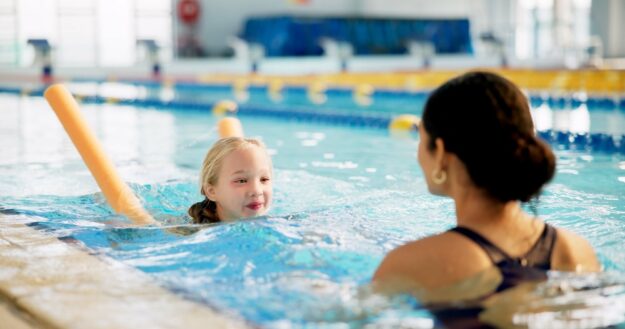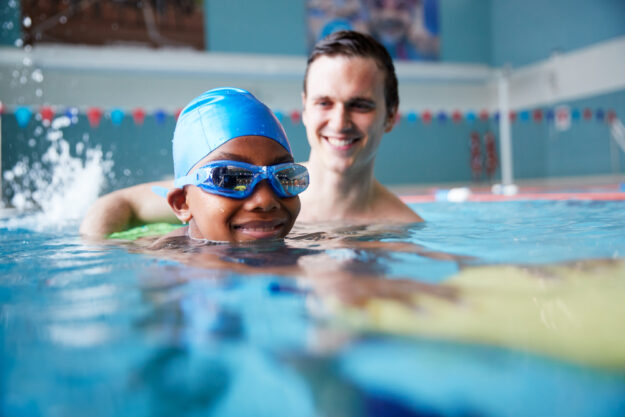Swimming is a life-saving skill that many of us take for granted. Not only does it allow us to participate in fun water-based activities, but it also offers numerous health benefits. Most importantly, knowing how to swim can prevent drowning if we unexpectedly fall into open water.
Whether you foster short-term or long-term, teaching your child to swim can enhance their mental well-being, keep them active, and help safeguard them near open water. But how do you go about it? In this article, we dive into the reasons to learn how to swim, explore the barriers children in care may face, and provide tips on accessing swimming lessons in your area.

Why teach a child to swim?
What age should a child learn to swim?
Swimming is part of the National Curriculum. In England and Wales, children are supposed to start learning how to swim between the ages of 7 and 9. However, the number of children who can swim in the UK is declining.
Nearly a third of children transitioning from primary to secondary school cannot swim. Contributing factors include the COVID-19 pandemic, pool closures, and fewer schools having the resources to facilitate swimming lessons.
As a result, it’s often left up to parents and caregivers to decide whether or not to enrol children in swimming lessons. This can be influenced by factors such as their financial circumstances, commitments, and their own ability to swim.
As a foster parent, part of your role is to encourage children in your care to develop life skills and support hobbies that enrich their lives. So, if your foster child can’t swim, here are some reasons to teach them.
Learning to swim reduces a child’s risk of drowning
Safeguarding children in your care is fundamental to being a foster parent, and teaching them to swim could help keep them safe. If you live close to a lake or plan on visiting the beach this summer, teaching your foster child to swim could help reduce their risk of drowning.
According to the Royal Life Saving Society child drowning report, between 2019 and 2023, incidents of children drowning doubled. Of these children, 51 drowned in inland open water and 23 in locations such as the ocean and swimming pools.
Although learning how to swim will not completely eliminate the risk of drowning, one study stated that it reduced rates of children aged 1 to 4 drowning by 88%.
Swimming can be a fun form of exercise
Although learning to swim is a skill that can save your child’s life, it’s also a fun way to encourage them to stay active. Swimming is a low-impact, full-body exercise that increases cardiovascular fitness and strengthens the muscles.
The good thing about swimming for children is that it can easily be made fun, so they don’t feel like they are exercising at all. Many leisure centres provide family fun sessions where children can play with toys and floats. They won’t even realise the positive impact it’s having on their bodies while they’re having so much fun.
Being able to swim also means they can go to water parks with slides, where they’ll combine swimming with walking up the stairs to get on the rides. They’ll also be able to take part in other water-based activities – such as kayaking, surfing, and paddle boarding – that will improve their fitness.
Swimming can have therapeutic benefits
Teaching your child to swim could positively impact their mental health. Like any exercise, swimming releases endorphins that reduce stress, make you feel good, and help you sleep better. It also allows your child to take a break from their phones, screens, and other distractions so they can fully immerse themselves in the moment.
If your foster child becomes a strong swimmer, they’ll be able to swim in the sea and specific lakes, which means they will also reap the benefits of swimming in nature.
These all contribute to positive mental well-being and can prevent anxiety and depression.
Overcoming barriers to swimming for foster children
Before jumping into the deep end, it’s essential to consider the possible challenges children in foster care may face when learning to swim

Trusting their swimming instructor
Many children in care have experienced abuse or neglect. This can impact the way they see the world, making it difficult for them to trust new adults, including swimming teachers.
In order for a child to feel safe enough to explore the world and try new things, they first need to build a secure relationship with you. At FCA, we use therapeutic foster care to help children understand their experiences and begin their trauma recovery. Our training programme also equips you with the skills and knowledge to build a trusting relationship with the child in your care.
When your child is ready to begin swimming lessons, you could help them build trust with the swimming instructor by introducing them to each other beforehand. Your child may also feel more secure if you join them in the pool during lessons. Having a trusted adult by their side can provide comfort if they feel scared, frustrated, or uncertain.
Sensory overload
When children experience prolonged abuse and neglect, their brains adapt to help them survive. One way they can adapt is through hypervigilance. Hypervigilance allows the child to quickly assess their surroundings for danger, which means they absorb sensory information more easily. As a result, environments like a swimming pool – where the smell of chlorine, water splashing in their face, and crowds flood their senses – can overstimulate them.
To help your child, consider enrolling them in one-to-one swimming lessons or lessons with a smaller group. Before they start, you could take them to the swimming pool – not to swim, but to allow them to acclimatise to the various sensations. When they’re ready to begin learning to swim, you could start with shorter sessions, gradually increasing time spent in the pool as they become more confident in their surroundings.
If they don’t like the sensation of water in their hair, ears, or eyes, you could also buy them goggles, earplugs, and a swim hat to make them feel more comfortable.
Fear of swimming
Children in care who have moved homes multiple times may have never been swimming before or had lessons interrupted. Some children may have also had a negative experience of swimming, all of which could make them afraid of getting in the pool.
If you’re thinking about teaching a scared child to swim, talk to them about how they feel about it and find out if there is anything you can do to help them feel less afraid. You could start with small steps, such as watching a swimming lesson together, so they know what to expect before getting into the water themselves.
Talk to the swimming instructor about your foster child’s worries so they can understand and adapt the lessons to their needs. You could also visit a leisure centre that has a small pool with steps rather than ladders, so they can gradually move into the water at their own pace. If this feels too overwhelming for them, you could begin even smaller by splashing their hands and feet with the pool water.
Confidence struggles
Many children in care struggle with their self-esteem and confidence. Don’t forget to praise every small step they take and offer reassurance and empathy if they are scared, frustrated, or unsure.
You could help boost their confidence by enrolling them in swimming lessons that award attendees with certificates for each milestone they reach, such as the Swim England Awards. Having a certificate to take home and proudly display will also give them a sense of accomplishment and could encourage them to keep going.
Another way you can support their confidence is by ensuring swimming becomes routine. Knowing when, where, and why things happen can put children at ease. So, whether you teach them to swim yourself or enrol them in lessons, ensure you make it routine by taking them to the same place on the same day and time each week.
Swimwear
If a child has experienced sexual abuse, wearing traditional swimwear could make them feel unsafe, uncomfortable, or frightened. So, it’s essential to prioritise their sense of control over their body and clothing choices.
Let them choose the type of swimwear they’ll feel most comfortable in. They may prefer full-coverage options, such as a long-sleeved swimsuit or a two-piece swim top with trousers. You could also buy them an over-the-head swim towel that they can leave on the poolside and quickly put on if they feel uncomfortable.
We’re here to help
If the child in your care refuses to start swimming, that’s okay. You should never force a child to do something they aren’t comfortable with. However, at FCA, we help you understand why they feel the way they do.
When a child can’t verbally express their thoughts and feelings, they may communicate them through their behaviour instead. Our therapy services and Team Parenting model help you look beyond your child’s behaviour to understand what’s really going on.
Don’t forget to tap into our supportive community, where you can connect with other foster parents who can offer advice based on their experiences.
Accessing swimming lessons
Although many leisure centres are closing due to a rise in operating costs, there are still plenty of swimming lesson providers throughout the UK.
If you’re fostering a child short-term, some swimming pools provide drop-in swimming lessons that allow you to pay as you go. Your child may also benefit from intensive swimming courses that usually run during the school holidays.
Some leisure centres and private pools also offer classes specifically for children and young people with sensory needs and disabilities, offering one-to-one sessions with carers and children. You can find out more about swimming lessons in your area on your local council website, through a quick Google search, or using the Swim England swim school directory.
Paying for Swimming Lessons
The cost of swimming lessons varies depending on whether they are provided by a local leisure centre or private companies, as well as the class size. For example, a one-to-one swimming lesson with a private company will cost more than a group lesson at a leisure centre.
When you foster with FCA, you receive a generous fostering allowance, which will help you cover the cost of swimming lessons for the child in your care. You also have access to our foster parent rewards platform, where you can receive discounts on swimwear retailers and health clubs with swimming pools.
Some local councils offer free or discounted swimming lessons for children in care, so it’s worth contacting yours to find out what they provide.
Start your fostering journey today
If you’re considering becoming a foster parent or want to transfer to an agency that’ll be by your side throughout your foster journey, get in touch today. Our friendly team are ready to welcome you into our diverse community and help you transform young lives.





